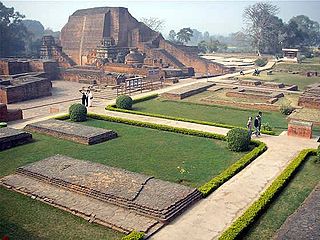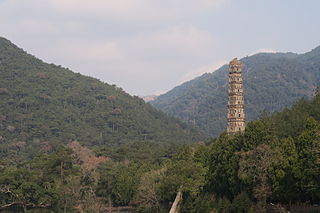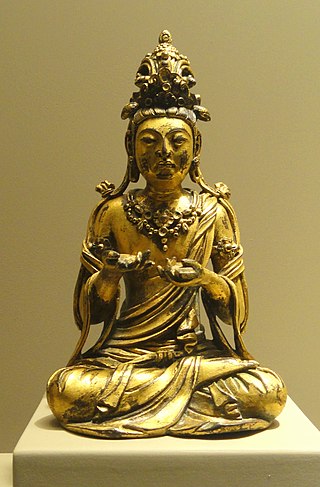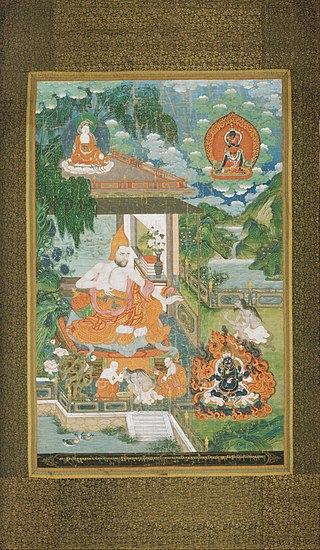
Buddhist philosophy refers to the ancient Indian philosophical system of the Buddhist religion. It comprises all the philosophical investigations and systems of inquiry that developed among various schools of Buddhism in ancient India following the parinirvāṇa of Gautama Buddha and later spread throughout Asia.
Nirvāṇa is a concept in Indian religions that represents the ultimate state of soteriological release, the liberation from duḥkha, suffering, and saṃsāra, the cycle of birth and rebirth.

Nāgārjuna [c. 150 – c. 250 CE (disputed)] was an Indian Mahāyāna Buddhist thinker, scholar-saint and philosopher. He is widely considered one of the most important Buddhist philosophers. Jan Westerhoff considers him to be "one of the greatest thinkers in the history of Asian philosophy."

Chandrakirti or "Chandra" was a Buddhist scholar of the Madhyamaka school and a noted commentator on the works of Nagarjuna and those of his main disciple, Aryadeva. He wrote two influential works on madhyamaka, the Prasannapadā and the Madhyamakāvatāra.

Śūnyatā, translated most often as "emptiness", "vacuity", and sometimes "voidness", is an Indian philosophical concept. Within Hinduism, Jainism, Buddhism and other philosophical strands, the concept has multiple meanings depending on its doctrinal context. It is either an ontological feature of reality, a meditative state, or a phenomenological analysis of experience.

Tiantai or T'ien-t'ai is an East Asian Buddhist school of Mahāyāna Buddhism that developed in 6th-century China. The school emphasizes the Lotus Sutra's doctrine of the "One Vehicle" (Ekayāna) as well as Mādhyamaka philosophy, particularly as articulated in the works of the fourth patriarch Zhiyi. Brook Ziporyn, professor of ancient and medieval Chinese religion and philosophy, states that Tiantai Buddhism is "the earliest attempt at a thoroughgoing Sinitic reworking of the Indian Buddhist tradition." According to Paul Swanson, scholar of Buddhist studies, Tiantai Buddhism grew to become "one of the most influential Buddhist traditions in China and Japan."
The English term enlightenment is the Western translation of various Buddhist terms, most notably bodhi and vimutti. The abstract noun bodhi, means the knowledge or wisdom, or awakened intellect, of a Buddha. The verbal root budh- means "to awaken," and its literal meaning is closer to awakening. Although the term buddhi is also used in other Indian philosophies and traditions, its most common usage is in the context of Buddhism. Vimukti is the freedom from or release of the fetters and hindrances.
The Mūlamadhyamakakārikā, abbreviated as MMK, is the foundational text of the Madhyamaka school of Mahāyāna Buddhist philosophy. It was composed by the Indian philosopher Nāgārjuna.

Prajñā or paññā, is a Buddhist term often translated as "wisdom", "intelligence", or "understanding". It is described in Buddhist texts as the understanding of the true nature of phenomena. In the context of Buddhist meditation, it is the ability to understand the three characteristics of all things: anicca ("impermanence"), dukkha, and anattā ("non-self"). Mahāyāna texts describe it as the understanding of śūnyatā ("emptiness"). It is part of the Threefold Training in Buddhism, and is one of the ten pāramīs of Theravāda Buddhism and one of the six Mahāyāna pāramitās.
Masao Abe was a Japanese Buddhist philosopher and religious studies scholar who was emeritus professor at Nara University. He is best known for his work in comparative religion, developing a Buddhist-Christian interfaith dialogue which later also included Judaism. His mature views were developed within the Kyoto School of philosophy. According to Christopher Ives: "Since the death of D. T. Suzuki in 1966, Masao Abe has served as the main representative of Zen Buddhism in Europe and North America."

Tsongkhapa was an influential Tibetan Buddhist monk, philosopher and tantric yogi, whose activities led to the formation of the Gelug school of Tibetan Buddhism. He is also known by his ordained name Losang Drakpa or simply as "Je Rinpoche". He is also known by Chinese as Zongkapa Lobsang Zhaba or just Zōngkàbā (宗喀巴).
The Buddhist doctrine of the two truths differentiates between two levels of satya in the teaching of the Śākyamuni Buddha: the "conventional" or "provisional" (saṁvṛti) truth, and the "ultimate" (paramārtha) truth.
The Svātantrika–Prāsaṅgika distinction is a doctrinal distinction made within Tibetan Buddhism between two stances regarding the use of logic and the meaning of conventional truth within the presentation of Madhyamaka.

Bhāviveka, also called Bhāvaviveka, and Bhavya was a sixth-century madhyamaka Buddhist philosopher. Alternative names for this figure also include Bhavyaviveka, Bhāvin, Bhāviviveka, Bhagavadviveka and Bhavya. Bhāviveka is the author of the Madhyamakahrdaya, its auto-commentary the Tarkajvālā and the Prajñāpradīpa.
Kumārila Bhaṭṭa was a Hindu philosopher and a scholar of Mimamsa school of philosophy from early medieval India. He is famous for many of his various theses on Mimamsa, such as Mimamsaslokavarttika. Bhaṭṭa was a staunch believer in the supreme validity of Vedic injunction, a champion of Pūrva-Mīmāṃsā and a confirmed ritualist. The Varttika is mainly written as a subcommentary of Sabara's commentary on Jaimini's Purva Mimamsa Sutras. His philosophy is classified by some scholars as existential realism.

Buddhism and Hinduism have common origins in the culture of Ancient India. Buddhism arose in the Gangetic plains of Eastern India in the 5th century BCE during the "second urbanisation". Hinduism developed as a fusion or synthesis of practices and ideas from the ancient Vedic religion and elements and deities from other local Indian traditions. This Hindu synthesis emerged after the Vedic period, between 500-200 BCE and c. 300 CE, in or after the period of the Second Urbanisation, and during the early classical period of Hinduism, when the Epics and the first Puranas were composed.

Mahāyāna is a term for a broad group of Buddhist traditions, texts, philosophies, and practices. Mahāyāna Buddhism developed in ancient India and is considered one of the three main existing branches of Buddhism. Mahāyāna accepts the main scriptures and teachings of early Buddhism but also recognizes various doctrines and texts that are not accepted by Theravada Buddhism as original. These include the Mahāyāna sūtras and their emphasis on the bodhisattva path and Prajñāpāramitā. Vajrayāna or Mantra traditions are a subset of Mahāyāna which makes use of numerous tantric methods Vajrayānists consider to help achieve Buddhahood.

Buddhist thought and Western philosophy include several parallels.

Advaita Vedanta and Mahayana Buddhism share significant similarities. Those similarities have attracted Indian and Western scholars attention, and have also been criticised by concurring schools. The similarities have been interpreted as Buddhist influences on Advaita Vedanta, though some deny such influences, or see them as expressions of the same eternal truth.
Jñānagarbha was an 8th-century Buddhist philosopher from Nalanda who wrote on Madhyamaka and Yogacara and is considered part of Bhāviveka's Svatantrika tradition. He was a student of Shrigupta and the teacher and ordaining master of Śāntarakṣita. Tibetan sources refer to him, Santaraksita and Kamalaśīla as rang rgyud shar gsum meaning the "three eastern Svātantrikas" indicating their origins from Eastern India.











